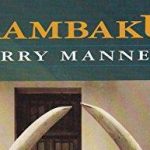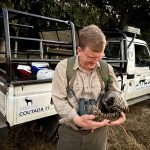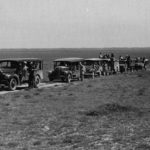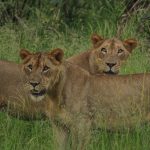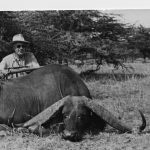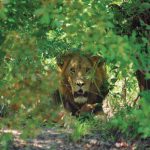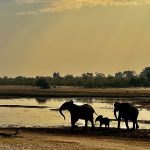Hunter-funded conservation reaches new heights as wild lions are reintroduced to one of Africa’s most important ecosystems.
In June 2018, 24 wild lions were flown from South Africa to Mozambique’s Zambezi Delta where they would spend the next six weeks in fenced bomas for observation before eventually being released. This project—the largest wild lion transfer across an international border in African history—is essential to the future of the species, but completing such an ambitious project required years of planning, research, and millions of dollars of funding—funding generated by hunters.
In truth, the story of this lion reintroduction began in 1994 when professional hunter Mark Haldane brought his first client into the Zambezi Delta to hunt buffalo. In the mid-twentieth century Mozambique was a premier African hunting destination. The firm Safrique controlled much of the Zambezi Delta and counted such legendary ivory hunters-turned-PHs as Harry Manners and Wally Johnson on their payroll. However, the area was decimated during the lengthy Mozambican Civil War that raged from 1975 until 1992 when local militias set up a base of operations in the delta and indiscriminately killed the local wildlife to feed troops and for profit. After the end of the war, displaced natives repopulated the depleted delta. At that time Mozambique was one of the poorest nations in the world and starvation was killing thousands of Mozambicans each year. In order to obtain meat, delta residents constructed lengthy brush fences with periodic openings which they lined with snares and leghold “gin” traps that further depleted the already devastated wild game populations in the area.
Initial game counts in the delta following the civil war told a grim tale; an aerial survey found that the population of 45,000 cape buffalo had been reduced to roughly 1,200 animals in Coutada 11’s half-million acres. A total of 44 sable antelope were found in the area, and there were less than 100 waterbuck. Selous zebra were once numerous in the area, but by the time the war ended only 5 animals could be located. A long-time delta resident recalled that when he arrived in 1998 it was not uncommon to drive for several hours without seeing any game in the area at all.
That didn’t stop Haldane.
“I fell in love with the area and I saw its potential,” he told me as we waited for the lions to arrive. Mark Haldane bought into the first safari company that operated in the area following the civil war—Zambeze Delta Safaris—and immediately began building an anti-poaching unit that initially numbered 5 officers who patrolled the vast area on foot. Haldane provided full-time employment for delta residents—a luxury few people in the area had ever known—and supplied starving villagers with a steady supply of meat, building strong relationships with the local people. Perhaps more importantly, he convinced the residents of Coutada 11 that a thriving ecosystem with healthy populations of wildlife could provide them with a valuable, renewable resource that would help improve their lives and the lives of their children. Mark’s work paid off, and the tide began to turn in the delta.
By 2013, the Zambezi Delta had been transformed by these efforts. Under Haldane’s watch buffalo numbers had risen to roughly 20,000. Sable antelope were estimated at 3,000, and the area currently has more sable per square mile than any other wilderness hunting area in Africa. Nyala, hartebeest, warthog, and eland were common on the floodplains. When Haldane began hunting the area he was offered one waterbuck tag per year that oftentimes went unfilled because he rarely saw a mature bull. When I arrived for the lion release in 2018 I saw a single herd of waterbuck bulls that numbered over 60 animals—one of several herds we saw that day. Selous zebra, nearly extirpated in the delta by the mid-90’s, now number in the thousands. Additionally, Haldane oversees one of the most successful and well-trained anti-poaching units anywhere in Africa. The area is now patrolled daily by helicopter which was funded by the Dallas Safari Club and fast-reaction anti-poaching teams that rely on motorcycles to rapidly intercept poachers. The funding for all of this came directly from hunters, though Haldane has reinvested a substantial amount of his own earnings back into the community and the delta. In addition to employing over 90 local villagers full-time, Haldane routinely patrols the area himself by helicopter. As game numbers increased so have the number of foreign hunters coming to the delta, and that influx of revenue has allowed the Zambezi Delta team to build a school which they supply with books and stationary, to dig wells, install a mobile corn mill (villagers previously had to carry corn over 35 miles to the nearest mill, and a portion of their corn was collected as payment for the service) and to provide villagers with transportation to hospitals in the event of a medical emergency. Prior to that delta residents had to walk a half-day to obtain medical attention—which they oftentimes didn’t reach in time.
For all Haldane’s success in the delta there was something missing, and that something was the roar of wild lions. The reason that lions had not repopulated such a game-rich area has not been positively identified, but a flight around the perimeter of the delta offers some insight into the forces that likely kept the big cats at bay. Flying in from Beira, south of the delta, there are vast unprotected areas where forests have been cleared for subsistence farming and villages. To the north, one of Mozambique’s busiest roads—and the human populations that reside along it—prove a natural boundary between the delta and nearby Gorongosa National Park. The delta, and all its rich wildlife resources and miles upon miles of prime habitat, was an island the cats could not reach due in large part to human interference.
In 2013 Haldane and Ivan Carter were sitting around a campfire at Haldane’s Mungari Camp in the delta and Carter proposed an ambitious plan to offer his support in reintroducing lions to the area. Though he was in favor of lion reintroduction, Haldane understood how difficult the task would be. But slowly the two men developed a plan of action that would, as Ivan Carter puts it, “move the needle” on wildlife conservation in Mozambique. There would be many risks and challenges involved with moving lions, and the cost in time and resources would be high, but both men agreed that the potential outcome—the return of a viable wild population to one of Africa’s most intact and well-protected wildlife areas—was worth the effort.
Carter, through his Ivan Carter Wildlife Conservation Alliance, began raising funds to help Haldane’s efforts. The ICWCA, as Carter says, “identifies heroes on the front lines of conservation and provides them with the tools, training and financial resources they need”. Haldane was the perfect candidate for such a program. ICWCA provided funds to purchase motorcycles for the anti-poaching teams, brought in experts from the Southern African Wildlife College to help train troops in modern anti-poaching tactics, provided support for helicopter reconnaissance operations to stem poaching and assisted with community engagement and upliftment projects. Of equal importance, the ICWCA enlisted the help of Doctor Byron du Preez, a lion biologist with 10 years of experience who played a crucial role in the highly-successful Bubye Valley lion restoration project in Zimbabwe. With the use of helicopters and radio collars provided through the alliance, Dr. du Preez began a long-term sustainability project to study the delta wildlife and determine whether or not a lion population would be viable in the delta. He found that, in addition to abundant prey animals, the delta had an especially attractive feature for lions—extensive ecotones. Ecotones are boundaries between various habitat types, and in the case of Coutada 11 these are represented by miles of palm savanna that separate the delta’s floodplain from the region’s sand forests. Lions, according to Dr. du Preez, tend to prefer these ecotones and spend most of their time there. To find an area with so few people, plentiful prey, zero livestock and long stretches of ecotones made the Zambezi Delta an ideal landscape for lions.
With the scientific data to support the lion move, Carter looked to enlist the financial support needed to begin the ambitious process, and that came through the Cabela Family Foundation. The Cabela family is one that is familiar to hunters, and they wanted to provide the financial assistance required for such an important recovery effort.
“Preserving wild Africa is very important to our family,” says Dan Cabela. “Ivan brought several different projects to us, and they were all great, but this lion project hit home. I knew this is one we would be interested in because of my mother’s (Mary Cabela) love of Africa and love of lions.”
All the essential elements were in place. The important next step was to procure lions, and for that the team turned to South African game reserves with wild, free-ranging cats. But moving wild game—especially a species like lions—is not an easy task. With Dr. du Preez’s data in hand, the team began finding lions with varied genetic backgrounds to prevent the possibility of inbreeding. The operation required filling out mountains of paperwork that included permits from local and national authorities, veterinary clearance, and much more. The process was anything but streamlined due in large part to the complexity and scope of the project, and the last official documents were signed and delivered only hours before the scheduled charter flights were booked and the darted lions were set to be transported to the delta. Another key element to the success of the project was to bring residents of the delta on board with the project so they would support the team’s efforts. Because of the presence of tsetse flies in the delta and the diseases they spread to livestock there were no domestic herds in Coutada 11, but if the local population was not in support of the lion move it could never succeed. Haldane’s long-standing relationship with the local villages plied the way for discussion, and Byron du Preez spoke to every individual in Coutada 11 about the cats and answered questions from an audience that was, at times, understandably skeptical about the prospect of having wild lions released near their villages. But the strong relationship that Zambeze Delta Safaris had forged with local communities provided the framework for an agreement to be reached, and with the support of the community and Coutada 11’s Chief Thozo the last hurdle was cleared. The largest international lion transfer in African history as set to begin.
Haldane and Alvaro Rola, who owns the government lease on the neighboring Coutada 10, forged an agreement between the two companies—essentially competitors—to work closely together on the transfer. Lions would be introduced to both coutadas, and I was present when the very first load of sedated lions, ten young females of breeding age, arrived at the airstrip beside Haldane’s Mungari Camp deep in the delta. A crowd of perhaps a hundred locals, most of whom had never seen a wild lion, watched as the first jetload of lions arrived on the delta. Carter and Haldane flew customs officials from Beira to Mungari Camp to facilitate competition of transfer permits when the lions arrived, the symbolic last step in the five-year process.
One-by-one the ten lionesses were offloaded as a veterinarian kept close watch over them while a sea of onlookers caught their first glimpse of a lion. Once the cats were loaded into Land Cruisers they were transported 45 minutes through the delta to a fenced boma where they would spend the next six weeks before their release into the wild. Local school children were brought out from the surrounding villages to examine the cats first-hand, a critical step since their attitudes toward the lions would eventually determine, in large part, the success or failure of the entire operation. Dan and Mary Cabela were on hand throughout the entire process. In addition to the lion transfer, the Cabela Family Foundation, in keeping with their “whole community benefit” philosophy, also funded construction of a medical clinic that would provide health care to the local residents. It was due to open the month after the transfer and would provide a higher level of health care to the residents than they had ever known.
As darkness fell there was a rush to transport the sedated lions to the boma where they would spend the next several weeks. Just before dark, the convoy of trucks and helicopters arrived and the cats were rushed one-by-one into the fence with no time to spare. Already having been under anesthesia for ten hours, the veterinarian made the decision that the cats must be given the antidote immediately and as quickly as the lions were laid out in the boma they were given a shot that would reverse the effects of the drug. Within a few moments the first of the eight lions (two others were on their way to a similar boma in Coutada 10) lifted her head and looked out into a foreign landscape hundreds of miles away from where her journey began as the last member of the lion transfer team slipped through the boma’s gate. Eventually all the lions rose and walked on unsteady legs into a grove of trees to sleep off the drugs. Byron du Preez watched their progress through a FLIR thermal scope to ensure that there were no ill effects from the anesthesia. When the last of the eight lionesses disappeared into the tall grass the long day ended with celebration.
I asked Mary Cabela, wife of the late Dick Cabela, why she was involved in the program.
“They say one person can’t make a difference,” she told me. “But we were able to make a difference here. I think Dick would be very proud.”
I agreed. As Dr. du Preez kept watch over the cats, accompanied by his wife and daughters, we loaded into the trucks and headed back to camp through the African night. In two days the second load of lions would arrive, and three lays later the final shipment would be in the delta.
The return of lions to the Zambezi Delta served to heal one of the last scars of Mozambique’s gruesome civil war. But there’s hope that the delta lions will become more than just a symbolic gesture of the return of wild Africa. Coutada 10 and 11 cover roughly a million acres of the finest game habitat on the continent, and with no cattle and very few people the area is a crucial wilderness. For perspective, Kruger National Park in South Africa covers an area that is roughly twice the size of the Zambeze Delta Ecosystem but Kruger is home to over 20 permanent camps and sees over a million visitors each year. The cats of the Zambezi Delta will live, in large part, free from human interaction. According to Dr. du Preez’s estimates the delta cats could eventually represent ten percent of the entire wild lion population on the continent. And even though the transfer was funded by hunters these cats were not brought here to hunt—a fact that Haldane and Carter both emphatically point out. Once the population rebounds there may be hunting here, but that days lies far in the future. These lions were relocated to improve the overall health of the delta’s ecosystem.
African lions don’t benefit from good will or caustic social media debates. What African lions need is habitat and protection from poaching, and both of those are now offered in the delta because of efforts Mark Haldane began a quarter-century ago. When these lions are released from their bomas they will walk out into an oasis that, not all that long ago, was virtually a wasteland. Hunters helped change the face of the delta, and now hunters have had a hand in one of the most ambitious and important wildlife relocation efforts in Africa’s history. But the work is not done. Poaching continues to be a problem, as evidenced by the mountain of wire snares and steel traps Haldane has collected, and his anti-poaching team recently arrested two Malawians who had heard about the delta’s wealth of wildlife and traveled hundreds of miles to exploit the area’s riches for profit. For now, though, these poachers will be met with a team of dedicated individuals who are willing to risk everything for the future of wildlife.
It won’t be long until the roar of lions can once again be heard in the delta. The needle has moved.
Learn more about this initiative at www.24lions.org. If you want to play a direct role in funding habitat restoration and anti-poaching efforts, please visit Zambeze Delta Anti-Poaching (www.zambezedeltaantipoaching.com), the Ivan Carter Wildlife Conservation Alliance (www.ivancarterwca.org), or the Cabela Family Foundation (www.cabelafamilyfoundation.org). You can also support the initiative through Ivan Carter’s Raindrop Initiative at www.theraindropinitiative.org.


